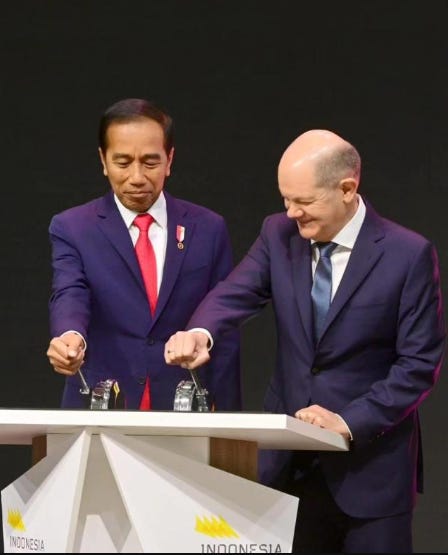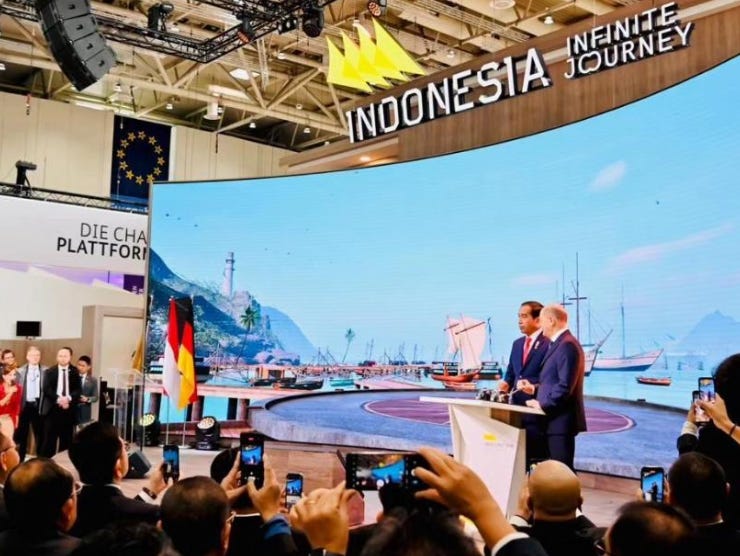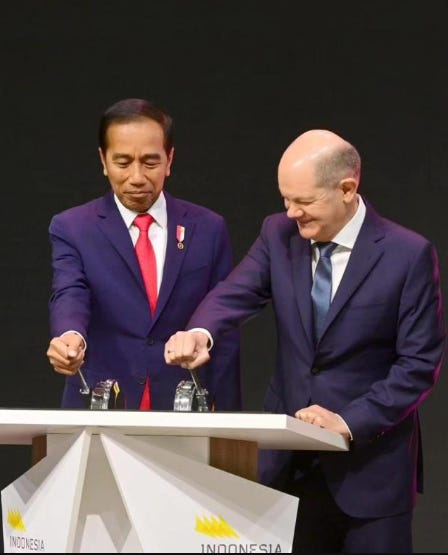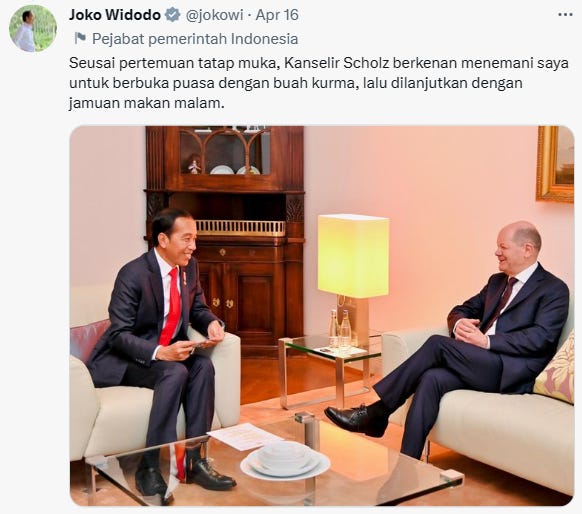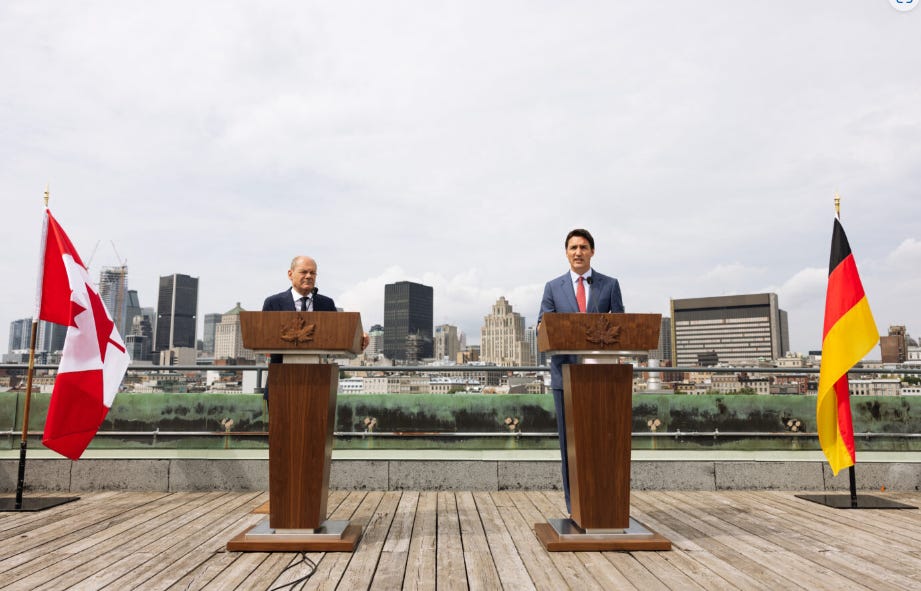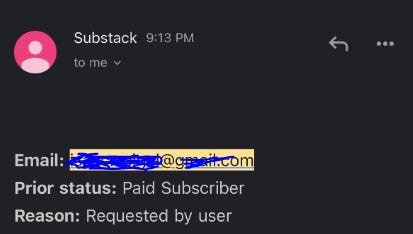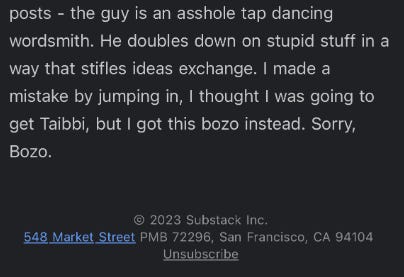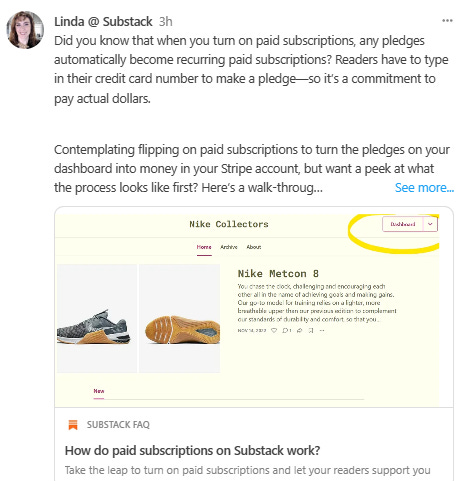How Much Offer to Secure "Long-Term" Electric Vehicle Project: Case Study Indonesia - Germany and Canada - Germany
To secure the massive new VW battery plant, Canada signed an unprecedented contract with the company to offer up to $13 billion in production subsidies over 10 years, effectively matching the U.S. incentives on offer. Canada is giving Volkswagen $13B over 10 years to set up a plant here just 4 years after a Toronto court charged the company for a $196.5 million fine for importing ~128,000 vehicles that violated national emissions standards.
Highlight: Many other cities in the world aren't as car-dependent like North American cities. Will that limit the revolutionary effect of EV & autonomous cars?
1 year ago, as of February '22, close to 66% of all EVs sold in India (arguably with same characteristic market like Indonesia — but India has a bigger population) are e-3W, followed by e-2W which comprises about 30% of the EV stock while the remaining 4% is e-4W and other heavy duty vehicles.
Indonesia (maybe) has a better potential than Canada and India. Should.
(Indonesia) should be rich simply by having a lot of natural resources is a myth that somehow always persists. Two issues:
a) What matters is not your absolute level of natural resource endowment, it's *per capita* natural resource endowment that matters. By that metric, it could very well be we're not actually "rich" in natural resources. The reason why countries like Qatar can be so rich is that they have these gigantic oil reserves with a population smaller than like Bandung.
b) What matters most for growth, at the end of the day, is the economy's ability to create value - and value comes from the production of complex goods and services goods and services that, among others, require a lot of technical know-how and have very long and very interdependent supply chains. Natural resources alone aren't gonna cut it.
Thailand, Indonesia emerge as bigger links in EV supply chain. Japanese parts makers see BYD and other Chinese automakers as potential customers. Toyota Motor and Honda Motor plan to make EVs in Thailand but likely will start at a small scale. But, there’s this big disconnect between foreign optimism on Indonesia becoming a global player in EVs and domestic skepticism on the idea of electric mobility.
You have US, EU, and China all investing massively in battery supply chains - considering them critical industries of the future. Literally spending hundreds of billions in incentives.
In contrast, we have widespread skepticism here among the public - even for any form of industrial policy on EVs. And you can’t say it’s unjustified. We’ve had decades of underinvestment in public transportation and we’re bearing the brunt of the environmental impact of the mining of minerals.
Indonesian Nickel will ultimately be needed to approach the green target and western should contribute to help instead of demonize Indonesia. Indonesia’s nickel boom tests Western green sensibilities. For example: Germany wants to help countries that are rich in critical minerals such as Chile, Indonesia and Namibia to build their own processing infrastructure to cut dependency on China, Chancellor Olaf Scholz said on Sunday alongside Jokowi on Hanover Messe 2023 to promoting Indonesia (especially new capital city IKN NUSANTARA). Jokowi visit Germany (April 15th - April 17th).
The Jakarta Stock Exchange enjoyed record ipo volumes in the first quarter. The $800m raised in these flotations outstripped the sums drummed up on Hong Kong’s or New York’s stock exchanges in the same period. The bulk of the money came from the listing of Pertamina Geothermal Energy, a green subsidiary of the state oil-and-gas giant. It may have been just the start of Indonesia’s clean-energy ipo boom. On April 12th Harita Nickel, a firm that processes the battery metal, pulled off the country’s biggest ipo in almost a year, raising nearly $700m at a valuation of around $5bn. Later this month Merdeka Battery Materials, another nickel firm, aims to raise more than $500m.
Nickel is at the centre of Indonesia’s efforts to become a clean-energy superpower. The country has one of the world’s two largest reserves of the stuff. In an attempt to capture more of the higher-margin markets for metal-processing and battery-making, a decade ago the government banned the export of raw nickel ore. Harita’s and Merdeka’s blockbuster ipos show that the policy is having an effect. But the industry also highlights some of the uncomfortable trade-offs involved in the global battery business.
Back again to Canada. Set to begin in 2027, the plant will be a “gigafactory,” or a facility that produces batteries for electric vehicles on a large scale, run by PowerCo, a subsidiary of Volkswagen, the company announced on Monday.
Arno Antlitz, the company’s chief financial officer, said a Canadian facility would give Volkswagen access to key minerals and clean energy, the “ideal conditions” needed “to take a strong position in the North American market.”
The news comes a few years after the auto manufacturer paid billions in fines and compensation for cheating on emissions tests and telling lies about the toxic pollution from a number of its diesel engine vehicles. In 2020, Volkswagen wound up paying a record fine of nearly $200 million in Canada over dozens of environmental infractions. It also offered more than $2 billion to reimburse customers who bought the vehicles.
Federal officials did not respond to questions from The Narwhal about whether there was any link between this case and Volkswagen’s new operations in Canada. In a statement, a spokesperson for Innovation, Science and Economic Development Canada said “Canada will continue to work with the company, following the March 13, 2023 announcement, to ensure that the announced investments will benefit Canada’s future as a cleaner and greener economy.”
Ontario Economic Development Minister Vic Fedeli noted Ontario could now offer the company “everything” on a “checklist” a Volkswagen representative gave him at a trade show in Germany last year: a skilled workforce, clean energy, an abundance of critical minerals, free trade agreements around the world and an already existing auto ecosystem.
Fedeli said details about this deal — including how much money Canada and Ontario have committed to the deal, how many jobs this plant will create and how many batteries will be produced — will be shared by the automaker in an on-site visit “soon, I hope” with Premier Doug Ford and federal officials in attendance. A date has not yet been set.
Volkwagen’s announcement is the first new investment from an automaker in Canada in 35 years, and makes Ontario home to six of the largest automakers in the world, “which is unprecedented for a country without its own domestic car makers,” Flavio Volpe, the president of the Automotive Parts Manufacturers’ Association, told.
Both Justin Trudeau and Doug Ford played a significant role to reach this electric vehicle battery deal with Volkswagen.
Since April 2022, the Ontario government has held at least seven meetings with Volkswagen representatives. Weekly meetings began last October and the last four significant discussions were held over the last three months at Queen’s Park with Doug Ford. “There is no better [deal] closer on the planet,” Fedeli said of the Ontario premier.
The support for electric vehicles is a stark shift for the Ford government. Since coming into power in 2018, the government has scrapped several incentive programs that made it attractive and cheaper for Ontarians to buy electric vehicles and install charging equipment. “It only benefitted millionaires who could afford Teslas,” Premier Doug Ford said at the time.
Over the last two years, the Ontario government has gone full-speed ahead with one electric vehicle announcement after another. Fedeli told The Narwhal they were delivering on phase two of its Driving Prosperity plan, which puts an emphasis on manufacturing electric vehicles in Ontario, promising to “reposition vehicle and parts production for the car of the future, establish and support a battery supply chain ecosystem, innovate in every stage of development [and] invest in Ontario’s auto workers.”
Volpe credits the Ontario government for “a relentless drive to reduce the cost of doing business here” and streamlining business standards.
Federally, a relationship with Volkswagen began just as the United States made significant moves to attract automakers. Last August, U.S. President Joe Biden signed a new climate law, which stipulates that 50 per cent of the battery components of an electric vehicle must be made in North America to qualify for electric vehicle tax credits. That same August, during a visit to Canada by German Chancellor Olaf Scholz, Volkswagen signed an accord with the federal government to boost the supply chain for batteries with a focus on raw minerals such as lithium, nickel and cobalt — all crucial raw materials in the production of batteries for electric vehicles, and many of which are found on the Ring of Fire, which is all First Nations land.
As of January 2023, Volkswagen CEO Oliver Blume and four other officials were listed in Ontario’s lobbyist registry to discuss economic development and trade, energy, infrastructure, manufacturing and transportation, among others. The same officials have been listed in the federal lobbyist registry since last October.
Volpe said this deal was a result of great teamwork between the federal and provincial government. “This is the textbook case on how to drop partisan allegiance and jurisdictional tuf at the door and just win the prize,” he said.
The new Volkswagen plant in St. Thomas will be built on farmland that Ontario recently consolidated in one town. St. Thomas is a small, rural Ontario municipality (population: 42,840) located halfway between Toronto and Detroit that was home to a Ford assembly plant over a decade ago. That plant’s closure meant the loss of thousands of jobs. The town is also about a 12-hour drive to Chattanooga, Tenn., home to a Volkswagen plant where electric vehicles are assembled.
The new Volkswagen plant is planned for a 1,500-acre agricultural site that spreads across St. Thomas and the neighbouring township of Central Elgin. Earlier in March, the Progressive Conservatives passed a bill consolidating that land into St. Thomas and reduced any regulatory requirements for industrial construction. Fedeli told The Narwhal this was necessary because it made it “one site in one jurisdiction, so there was just one municipal government to deal with.”
The decision is controversial because it means Central Elgin, which previously had authority over 75 per cent of the land, no longer gets any revenue from the construction of the Volkswagen plant. The decision to consolidate the lands and turn it into a site for the electric vehicle battery plant was also made with no public consultation.
But the economic activity Volkswagen will bring to the region may make up for that, according to advocates. “The fact that the 1,500-acre plot has been turned over to a likely 2,500-job site that resurrects a car town is probably a suitable sacrifice most would be willing to make,” Volpe said.
With St. Thomas plant, Volkswagen is just the latest company to joining Canada’s growing electric vehicle ecosystem.
Volkswagen’s electric vehicle battery factory is the third major plant to be announced in the province.
Stellantis NV and LG Energy Solutions announced Canada’s first auto-battery factory in Windsor, Ont. — a close to $5-billion investment that will employ about 2,500 people, with full production expected by 2025. General Motors will invest nearly $1 billion to bring the production of the BrightDrop EV600 electric vehicle to its manufacturing plant in Oshawa. The government of Ontario and the federal government each committed $295 million toward the renovation of Ford’s Oakville assembly plant, which will exclusively build electric vehicles.
And a Belgian company, Umicore, which has a partnership agreement with Volkswagen, announced it will open a $1.5-billion electric vehicle battery plant in the Kingston area.
Manufacturers have also recently made similar announcements in neighbouring jurisdictions. In February, Ford Motor Company announced plans to create 2,500 jobs at a multibillion-dollar electric battery factory in Marshall, Mich. The American manufacturer had considered building this facility in either Canada or Mexico, but opted for the U.S., due to new tax breaks introduced by the Inflation Reduction Act
Volkswagen received Canada’s biggest environmental fine. In September 2015, the European automaker was rocked by revelations that several of its diesel models in the U.S. had been equipped with software designed to cheat on emissions tests. The vehicle’s nitrogen oxide emissions were 40 times higher than what U.S. standards permitted. The automaker has admitted that more than 11 million vehicles across the globe were implicated, despite widespread marketing its cars were low emissions.
The scandal, dubbed “dieselgate,” rocked many countries, including the U.K., Italy, France, South Korea, Germany and Canada and resulted in over US$30 billion in fines and damages. In December 2019, a Toronto court charged Volkswagen with a record-setting $196.5 million fine for importing nearly 128,000 vehicles into Canada that violated national emissions standards. The automaker eventually settled consumer claims with close to $2.39 billion in compensation and benefits, as well as a class action suit involving 105,000 people in Quebec and Ontario. Dozens of Volkswagen officials, including the former CEO, were charged and sentenced over the scandal.
There are few programs in place that would prevent this from happening again in Canada, despite wide calls for tighter emissions rules for automakers. Ontario’s emissions-testing program, Drive Clean, was eliminated when the Ford government came to power.
Since the scandal, Volkswagen has set up a sustainability council that meets several times a year to help lead decarbonization and electric mobility efforts.
There’s still challenges ahead: retraining a workforce, powering a massive electric vehicle battery plant. Volkswagen’s electric vehicle battery plant in St. Thomas may revive an old automotive town but to do so will require a longlist of things including housing, transit, retraining programs for a burgeoning workforce and a lot of energy supply.
“The biggest challenge is the best one to have,” Volpe told The Narwhal. “We need thousands of people to work in this plant for suppliers to it. Likely in the region of 5,000 people, it will be a challenge to recruit. We do, however, have a three to four year lead time.”
——
-prada- (Adi Mulia Pradana) is a Helper. Former adviser (President Indonesia) Jokowi for mapping 2-times election. I used to get paid to catch all these blunders—now I do it for free. Trying to work out what's going on, what happens next. Arch enemies of the tobacco industry, (still) survive after getting doxed.
(Very rare compliment and initiative pledge. Thank you. Yes, even a lot of people associated me PRAVDA, not part of MIUCCIA PRADA. I’m literally asshole on debate, since in college). Especially tonight heated between Putin and Prigozhin.
========
Thanks for reading Prada’s Newsletter. I was lured, inspired by someone writer, his post in LinkedIn months ago, “Currently after a routine daily writing newsletter in the last 10 years, my subscriber reaches 100,000. Maybe one of my subscribers is your boss.” After I get followed / subscribed by (literally) prominent AI and prominent Chief Product and Technology of mammoth global media (both: Sir, thank you so much), I try crafting more / better writing.
To get the ones who really appreciate your writing, and now prominent people appreciate my writing, priceless feeling. Prada ungated/no paywall every notes-but thank you for anyone open initiative pledge to me.
(Promoting to more engage in Substack) Seamless to listen to your favorite podcasts on Substack. You can buy a better headset to listen to a podcast here (GST DE352306207). Listeners on Apple Podcasts, Spotify, Overcast, or Pocket Casts simultaneously. podcasting can transform more of a conversation. Invite listeners to weigh in on episodes directly with you and with each other through discussion threads. At Substack, the process is to build with writers. Podcasts are an amazing feature of the Substack. I wish it had a feature to read the words we have written down without us having to do the speaking. Thanks for reading Prada’s Newsletter.





